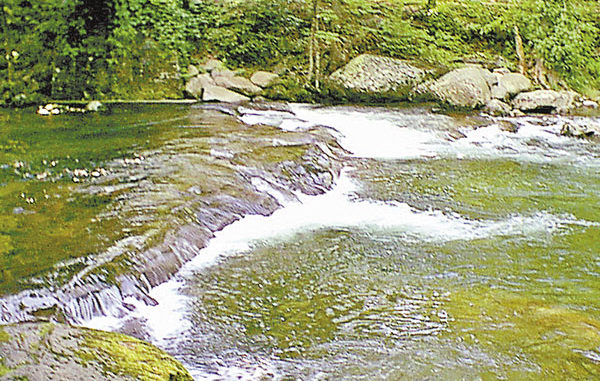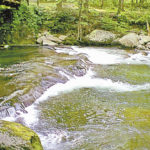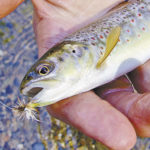
Hunkered under the wide limbs of a huge spruce, I waited out an early summer rainstorm, a hard, pounding, gully-washer kind of rain. The big tree was trying its best to provide shelter, but the rain quickly found me. Water dripped down my face and down my collar. Might as well have stayed in the open. My rain jacket was in my car, a good two miles away.The rain had come up suddenly. No lightning flashes, no thunder, just a light sprinkle that I ignored because I was in a nice stretch of stream on Little Cataloochee Creek that I hadn’t thoroughly worked. There wasn’t even a decent pause between sprinkle and downpour. I was wet before I made the 15 feet to the spruce.
A kingfisher eyed me from a limb across the creek, cocking his big head with the bad haircut before he dived into the stream and retrieved a small fish. He returned to his limb and gave me another look. Show-off. I knew what he was thinking.
I squatted under that spruce for 30 minutes, waiting for the rain to ease up. It stopped as abruptly as it began, as if someone had closed a spigot. It was 2:30 p.m. I had been on the creek an hour-and-a half, and I hadn’t caught a trout. Little Cataloochee is like that; it’s either on or off.
From the bridge above the group campground, I worked downstream, starting with a No. 18 Light Cahill, which hadn’t raised anything, but I have a lot of confidence in Cahills. It snagged on a limb across the stream, and I couldn’t get it loose without diving in. I broke it off and looked for another fly. No Cahills, so I tied on a yellow Palmer.
Two casts later, I caught my first trout, a 6-inch rainbow. It was a pretty fish, but too small. I let it go. I wanted trout for dinner. A couple of 10-inchers would make a fine supper. I caught five more rainbows, all small, none larger than seven inches.
By 4 p.m., I had caught eight more trout, all rainbows, but I let all of them go. Still no 10-inchers. I was thinking about trout fried to perfection in a cast-iron frying pan, or maybe marinaded and baked in the oven, or even grilled. Just thinking about it caused me to salivate. Small trout make mighty fine eating, but it would take at least four 7- or 8-inchers to make a meal. If I could catch two 10- or 12-inchers, that would be plenty, and I wouldn’t have to kill so many fish.
In a small pool where a rock divided the current, I caught my first brown trout. It was so beautifully marked that the rose moles on its sides seemed to glitter. It measured nine inches. I returned it to the stream. Just too beautiful to kill.
I fished every large pool, confident that large trout were waiting in the depths. I was losing confidence in the Palmer and was thinking about switching patterns. It seemed stuck on 8-inch trout. I knew that big trout lived in this snug-harbor valley stream in the Great Smoky Mountains National Park. I had seen pictures of trout that took two arms to hold. If I hit every pool and fished it up and down and crossways and sideways, maybe one of the big boys would grab my fly, and I, too, would have a story of a mighty struggle to tell.
The farther I went, though, the smaller the trout. I caught a couple of feisty 4-inchers that fought as if they were twice that size. In a year or so, they would be jerking arms out of sockets.
I worked downstream until I found some fishable water. Behind a large flat rock was a table-sized pool, an easy cast, but a limb jutted about two feet above the pool. With a very careful, and lucky, cast, I could drop that fly at the top of the pool. I cast, and the line landed on the limb, but the fly was dead center in the pool. It was not the worst cast of the day, but it certainly tied with a bunch of bad ones. I tried to ease the fly over the limb, so I could flip it out. When the fly moved, I saw a flash and felt the line go taut. I had a trout on, and it was a big one. The line pulled free of the limb as the trout began its run. I finally had a keeper — a fat brown trout that stretched almost to the 12-inch mark on my creel.
This was the eating-size trout I had been waiting for, and it alone would make a fine meal. I looked it over, and before my stomach realized what was happening, I placed the fish back in the water and watched it dart away. Wild brown trout are just too pretty to kill. It was almost dusk, and I didn’t have my trout dinner, but I’d had my thrill for the day. It was time to quit.
Before I left the house that morning, I had put the mixings for vegetable soup in a crockpot, the ingredients all garden fresh. A slab of hot cornbread to go with it would make a mighty fine supper. It wouldn’t be as good as a trout dinner, but it would be a close second.
I was wet from head to feet. I had scratches on my arms, insect bites on my ears, a sore rear-end from falling in the water, but all I thought about as I walked up that road to my car was what an absolutely wonderful day I’d had.






Be the first to comment